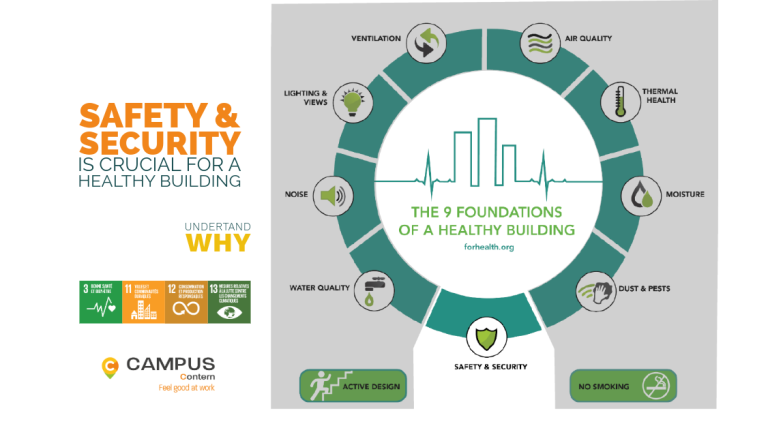Safety and security are fundamental to human health and well-being, as highlighted by Maslow’s Hierarchy of Needs, where they rank just above basic necessities like food and water.
Buildings play a crucial role in providing this sense of security, protecting occupants from various threats, including crime, violence, and environmental hazards. The design and operation of buildings significantly influence not only physical safety but also the psychological sense of security, both of which are vital for overall well-being.
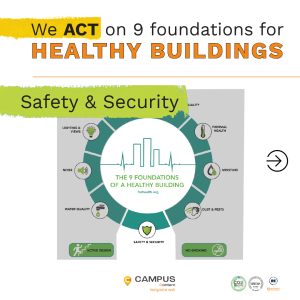
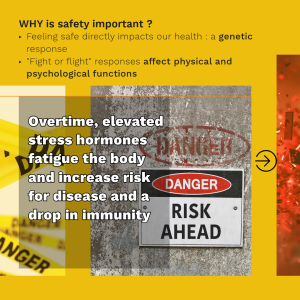
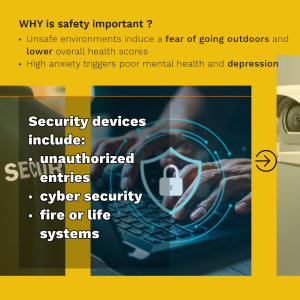
Why is it important for our health?
When people feel unsafe, their bodies activate a “fight or flight” response, releasing stress hormones like cortisol and adrenaline.
While this response is useful in emergencies, chronic stress caused by persistent feelings of insecurity can have harmful long-term effects on health. Prolonged exposure to these stress hormones can suppress the immune system, increase blood pressure, and heighten the risk of cardiovascular diseases.
For example, 65.1% of people report feelings of anxiety and stress due to fear of crime, with 27.4% experiencing sleep difficulties and 10% suffering from depression. Elevated stress levels can lead to autoimmune diseases, exacerbate inflammatory conditions, and contribute to mental health disorders such as Post-Traumatic Stress Disorder (PTSD).
How does it manifest in our daily lives?
Fear of crime also limits social interactions and physical activity, further degrading both mental and physical health.
People who worry about crime are 1.5 times more likely to develop a common mental disorder and nearly twice as likely to experience depression compared to those with lower levels of fear. Moreover, this fear/stress can contribute to physical inactivity, leading to higher body mass index (BMI) and a greater risk of obesity-related health problems.
Studies have shown that people who perceive their neighborhoods as unsafe have higher BMIs and lower self-reported physical health.
Children are particularly vulnerable to the effects of insecurity. Unsafe environments in schools or neighborhoods not only disrupt academic performance but also contribute to poor health outcomes.
Research has linked exposure to neighborhood violence with lower test scores in subjects like English and math. Additionally, children in unsafe neighborhoods are more likely to experience poorly controlled asthma, with higher rates of symptoms such as breathlessness and nighttime coughing.
What can we do?
To mitigate these negative effects, building design must prioritize security measures such as locks, fences, secure entry systems, and surveillance cameras.
For instance, after enhanced security measures were introduced in Liverpool, U.K., residents reported significantly lower fear of domestic crime, which corresponded with improved mental health.
Well-designed security features can reduce fear and promote a sense of well-being, highlighting the potential for aligning security strategies with public health goals.
This holistic approach can create environments that not only protect people but also enhance their mental and physical health, making secure buildings a cornerstone of a healthy community.
@CAMPUS CONTERN it means :
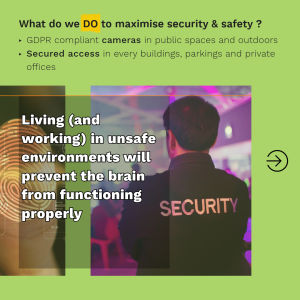
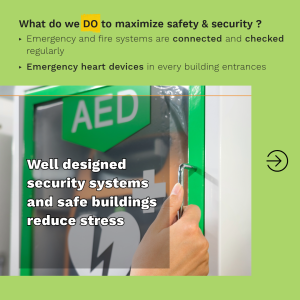
- We have a strict control access system where tenants can only enter their building and their office.
- Our indoor parking lots are only accessible to people who do rent parking spaces.
- We have GDPR compliant cameras in public or outdoors areas
- We installed easy-to-use defibrillators in every building entrance
- We check our fire and emergency measures as often as required
- Our emergency system is connected and carefully monitored
Our Goal :
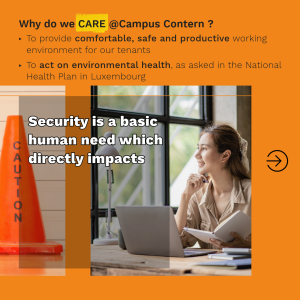
- To make sure that our tenants have a safe and healthy work environment. They spend a lot of time in our buildings, it is our responsibility to do our best to reduce the causes of fatigue, absenteeism and to foster concentration and performance
- To protect our tenants from chronicle diseases and play our part in the National Health Plan
Source : “The 9 foundations of a healthy building” Harvard School of Public Health – forhealth.org
